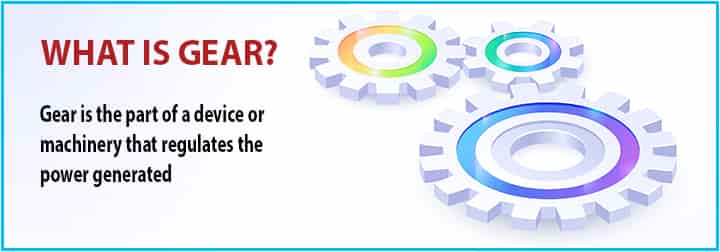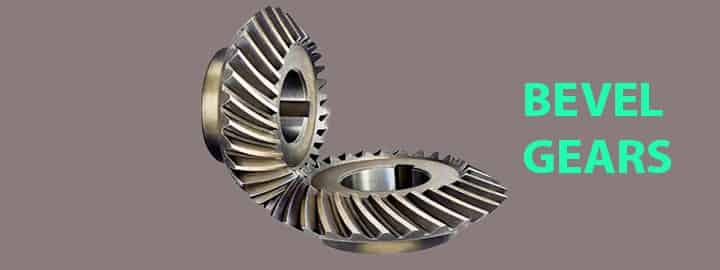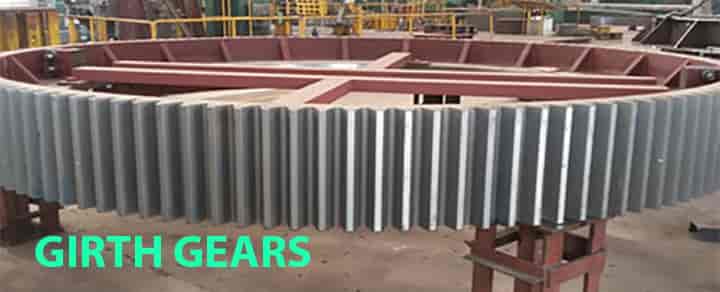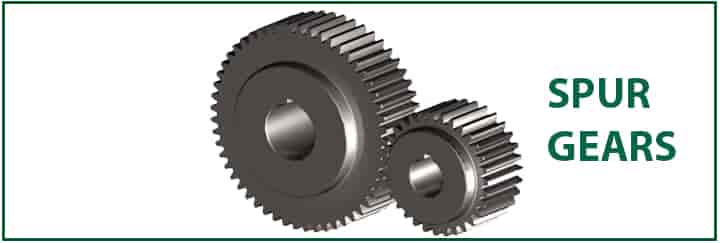Gears are explained in simple language along with basics, definitions, types of gears, teminology, materials, advantages, disadvantages, etc.
Let’s explore Gear!
Basics & Types of Gears?
Let’s try to understand the basics of gear along with definitions!
Basics of Gear
The evolution of humanity massively depends on automation and continuous growth in technology.
This evolution’s significant share holds the different types of machinery such as automobiles, heavy machines, and various others.
Machines and automobiles are equipped with some of the parts that play a significant role. One of those parts is gear which are among the critical ones.
What is Gear?
In layman’s language, gear is the part of a device or machinery that regulates the power generated. In the case of automobiles or any vehicle, it is used for regulating the power of the vehicle’s engine.

With this definition, the function of gears is quite clear. However, the use of these gears in the industrial front is quite effective and also attained a peak position.
- In the present time, the gear has also experienced continuous evolution.
- The application and scope of the industrial gear are getting vital day by day.
- Gear has a lot of applications in numerous sectors.
Some of the prominent sectors that have massive usage of gears are,
- aviation,
- food-processing,
- medical,
- cement,
- defense,
- fertilizer,
- railway,
- steel, etc. these are only a few, using this efficient part in abundance.
Types of Gear
Mainly there are five different kinds of gears based on shapes and functions. These are as follows:
- Bevel Gear
- Differential Gear
- Girth Gear
- Helical Gear
- Spur Gear

Now, these all types of gears will be explained one by one but before understanding further about the different types of gear, it is vital to get an understanding of some of the critical parameters or gear terminology.
These parameters define the efficiency of the gear.
XPH is your home for BMW, Audi, Ford Mustang, VW, Porsche and Nissan GTR aftermarket parts.
Terminology of Gears
Following are some of the parameters that provide an idea of the specifications of the gear. These terms will be present in abundance in every aspect of this informative article about gear:
Outer diameter
It is precisely the distance from the tooth tip to the gear body center. This can be the maximum diameter of a gear.
It specifically provides an idea of the whole outermost part of the gear.
Pitch circle
The primary purpose of the pitch circle is motion transfer. It is used for calculation.
- Simply it is the point where two gears touch each other.
- At this point, the mating gear comes into play.
- Apart from that pitch point is the specific point on which the gear touches each other.
Center distance
The distance between the mating gears of a system is called center distance.
- It is pretty mandatory to set this right as it is responsible for the efficient transfer of torque.
- This is the sum of the pitch circle diameter of the two gears divided by two.
- This specific rotation is also used for calculating the specific gear.
Root
The point at which the tooth of the gear body comes into contact is known as the root.
- Root diameter is the distance between the base of a gear teeth to the gear body’s center.
- While manufacturing two mating gears, it is essential to cut the tooth’s height so that it doesn’t exceed.
- This helps keep a check on the contact tip of the other gear root while being in rotatory motion.
Tooth Profile
The shape of the gear tooth is known as the tooth profile. It comes in different varieties. It can be triangular or rectangular though these conventional and simple profiles provide inefficiency.
- It is proven that more complexity in the tooth profile provides maximum efficiency and vibrationless operation.
- These complex profiles are pretty effective such as circular arc, an involute, or parabola.
One of the most common and widely popular tooth profiles is involute. This is because of the simple and cost-effective approach for manufacturing.
Apart from this, the cycloidal tooth profile is among the second most effective. It is used for intensive purposes, and manufacturing is quite difficult.
After getting an idea about the different parameters associated with gears, it’s time to understand different gears.
Spring is here! Save big on our best-selling WAGNER TUNING BMW F CHASSIS N55 CATTED DOWNPIPE
Description of Gear Types
Let’s explore the basic details of gear types,
- Bevel
- Differential
- Girth
- Helical
- Spur
Bevel Gears
Bevel gears are conical-shaped gears in which the teeth have meshed together. These gears are specifically used when there is a need to change the shaft’s rotatory motion direction.
- With these gears, it is pretty convenient to decrease or increase the rotational speed.
- These gears come in different numbers of teeth.
- These can be installed in 90-degree angles though it also works on different angles.
- One of the main reasons that make this gear quite useful is its usage in the initial adjustments.

These types of gear teeth are placed on the conical surface. In these cases, two mating gears are used to mount on perpendicular intersecting shaft axes.
Use
- Widely used for changing the power transmission axis.
- Some of the equipment that uses bevel gears are pumps, machine tools, automobiles, food packaging equipment, fluid control valves, and gardening equipment.
Advantages
- Easy to manufacture
- Affordable
- Available in a variety of sizes
Disadvantages
- Excessive noise
- Vibration
- High stress
- Less durable
Differential Gears
Most automobiles use differential gear . The primary function of these gears is to provide a link between two separate shafts.
. The primary function of these gears is to provide a link between two separate shafts.
- It provides a covering and also helps in the tuning of the total rotational angles.
- The design of these gears is based upon the need to produce high torque.
- This high torque is beneficial as it is transmitted to the axle shaft.
- Differential gears also have a set of coaxial gears which includes turntables and pinions.
Use:
- It is used in the automotive industry.
- Apart from that, it can also be used in the non-automotive industry.
- It is also used in complex vehicles such as off-road and also in ATV.
Advantages:
- Better weight balance
- Better acceleration
- Better Road Holding
- Better Stopping
Disadvantages:
- High costing
- Complicated system
Girth Gears
These are the gears that have a multitude of industrial applications. These gears are pretty different from others as they are manufactured in numerous segments such as two, four, or eight equal sizes.
- These kinds of gears’ practical benefits are their easy installation, low initial cost, and simple operation.
- These are also divided based on standards that define the efficiency of the same.

Use:
- Girth gears are most frequently used in “cold” processing equipment such as SAG (semi-autogenous grinding) mills.
- These are also used in ball mills, such as in mining and cement industries.
Advantages
- Provides maximum accuracy
- Easy installation
- Low cost associated
Disadvantages:
- residual stresses
- excessive wobbling
- cranking
Helical Gears
When it comes to prominent and popular industrial gears, then helical gears come at a prominent place.
- It has involute teeth that mesh around at an angle which helps it withstand and produce maximum thrust load.
- It is named helical due to the teeth structure that is curved in a helical path.

Use:
- The basic usage of this kind of gear is in those areas where we need maximum accuracy.
- Apart from that, there is a need for smooth operation, and we use these helical gears as they are comfortable carrying heavy loads.
- This happens due to the enhanced surface contact.
Advantages:
- Can sustain higher loads
- Gradual loading capacity
- Combined load sharing
Disadvantages:
- Power loss while operating
- Low thrust
- Readily needs lubrication
Spur Gears
There are some of the types of gears used widely, both for industrial and non-industrial purposes. The practical shape of these gears is a cylindrical or disk-like structure.
- The effective use of this gear is on generating variations in the speed and force of the rotating axles.
- These gears are the most simplistic type of gears.
- These are used in combination with spur gears as per the requirement.

Use:
- Spur gears are specifically used in those places where moderate load and moderate speed are required.
- These are also used for the operation in those products where there are minimal noise and vibration.
Advantages
- Simple design
- High transmission efficiency
- Dynamic torque and RPM
Disadvantages
- High noise
- Excessive vibration in high-speed applications
- A great amount of stress load
- Limit in loading capacity
Apart from the above types, there are some other factors on which gears can be differentiated, such as,
- Torque/duty cycle needs,
- Rotation speed/gear ratio,
- Service environment,
- Space availability/restrictions,
- Budget.
Based on these factors, we can specify some other kinds of gears also.
Material for Gears
After getting an idea about the different kinds of gears now, we will help you understand the different materials used for manufacturing gears.
- There are a variety of materials that can be used for manufacturing as per the needs.
- These materials can be different kinds of metals or non-metals.
- With their specific properties, these can be used as per the needs.
- The following are some of the materials:
Cast iron
These are easy to produce and prefer for manufacturing gears when there is a need for mass production.
However, you cannot expect accuracy and precision in the gears made of cast iron.
Steel
Some gears are quite complex and intensive. Those gears which need massive hardness and strength can be manufactured of steel.
There are other alloys, such as alloy steel or carbon steel, that are commonly used to manufacture the same.
Nylon
When it comes to affordable material selection for the manufacturing of gears, then we use Nylon.
- These are non-corrosive, lightweight, and withstand the low load.
- These features make it quite effective to use as a material for gear manufacturing.
After getting hands-on knowledge about different kinds of material, there is a core need to understand some of the processes that are quite effective for the long-lasting life of the same.
Surface Treatment of Gear
Surface treatment is the most significant process that is used for this purpose. Under this, several methods can be adopted for the surface finishing of gear.
Two of the basic processes are Grinding and Heat treatment.
Grinding
This process is specifically used for making the teeth of the gear smooth. It leads to the quiet operation of the same.
However, for using this process, there is a slight increase in cost.
Heat treatment
There are numerous heat treatment processes available that are being used for improving the,
- surface finish,
- durability, and
- strength of the gear, such as annealing, tempering, carburizing, surface hardening, and normalizing.
With these processes, one can specifically choose the desired one as per the selection of material to manufacture gear.
Industry Applications of Gear
The primary use of gear is in industries. Industries use different kinds of gear as per their need. They even customize it and then use it in additional equipment. The various applications of these gears are in
- Cement Plants Industry
- Petrochemical Industry
- Sugar Mills
- Power Industry
- Mining Industry
- Steel Rolling Mills
- Oil refineries
- Sugar Mill Drives
These are some of the core industries which use gear for every sort of work. Without gear, it is impossible to think about the operations of different machines.
Advantages of Gear
There are many advantages of gear, these are followed,
- Higher loading capacity,
- Compact in design,
- Higher efficiency,
- Transmit high torque,
- Reliability,
- Cost-effectiveness,
- Efficient Quality,
- Low maintenance, and optimizing the gear performance,
- Easy application at the high speed and low speed,
- The velocity ratio can be changed or controlled with the help of a gearbox.
Disadvantages of Gear
There are few disadvantages as well of gear, as follows,
- In case of a very high-speed application, noise, as well as vibration, will produce,
- Gear connects two shafts, so if both the shafts are close. In case, shafts are at a distance belt drive to be used instead of gear.
- Lubricating oil or a dedicated lubricated system to be used.
Reasons of Gear Failure
Do you have any idea that gear can be failed or broken? There are many reasons like,
- Improper lubrication
- Abrasive wear
- Improper design
- Corrosive wear
- Improper clearance
- Pitting
- Lack of maintenance
- Scoring
Manufacturers of Gear
There are so many manufacturers available for gear, like
- Omni Gear & Machine Corporation
- Gear motions
- Bajrang Engineering
- Timken, etc.
High Rated Automotive Engineering Course
Automotive 101: A Beginners Guide To Automotive Repair
Automotive Engineering: Automobile Fundamentals and Advanced
Automotive Engineering; Hybrid Electric Vehicles
Do it Yourself – Automotive Electrical Diagnosis – Beginner
Do it Yourself-Automotive Electrical Diagnosis-Intermediate
Automotive Engineering; Common Rail Direct Injection(CRDI)
Fundamentals of Internal Combustion Engines – IC Engines
Hybrid and Electric Vehicle for Beginners FULL Course 2021
Automobile Safety: Understanding Car Crashes for beginners
Hybrid Vehicles The Fundamentals & Operating Principles
Conclusion
Hence, we understand that this article holds information about the basic parameters of gear.
Apart from that, here we learned the basics, different types of gears, and the materials used for the manufacturing.
Any comments, please let us know.
